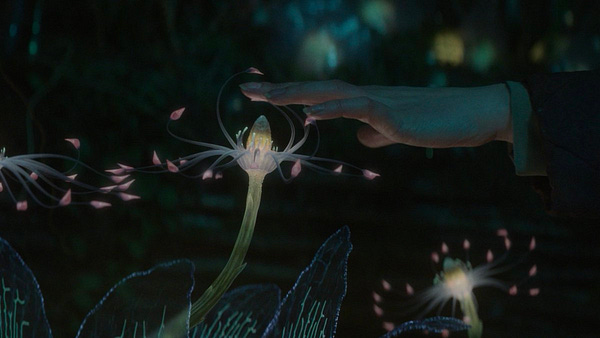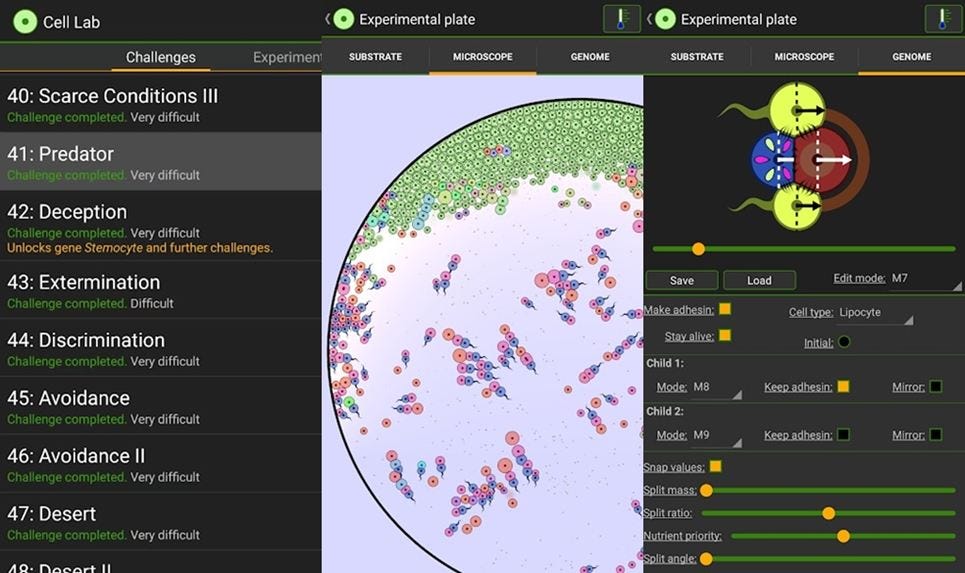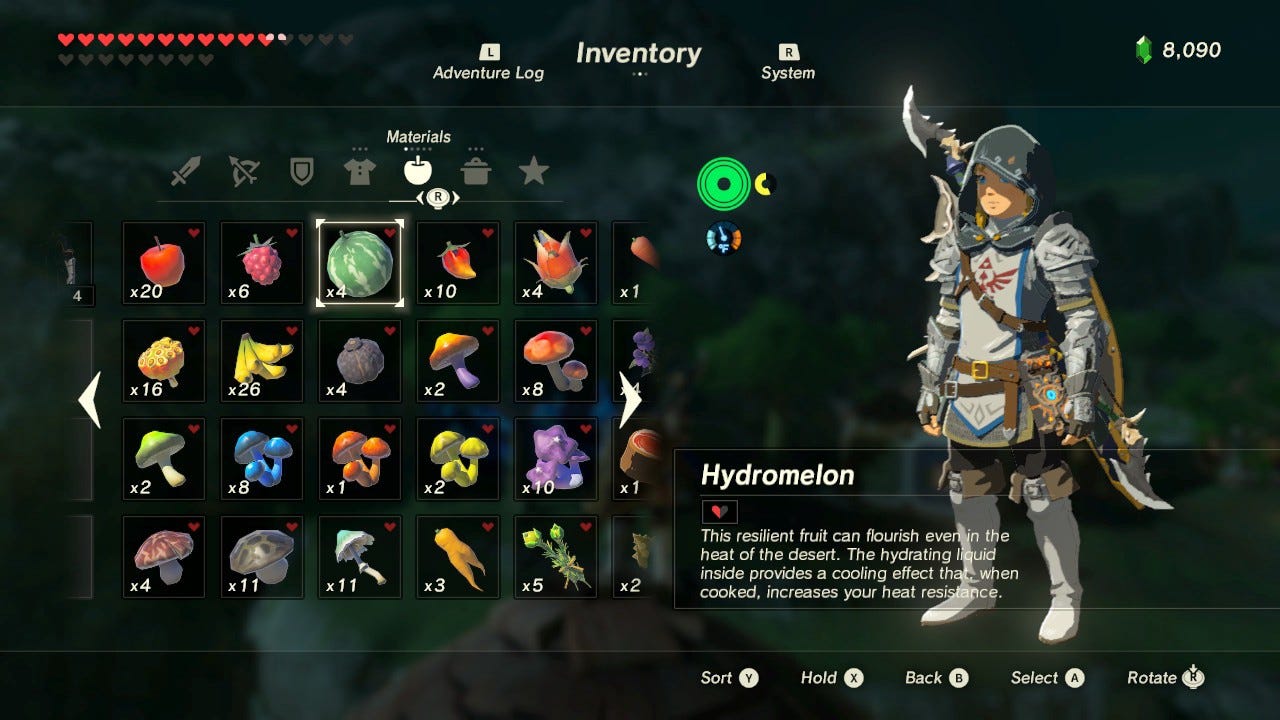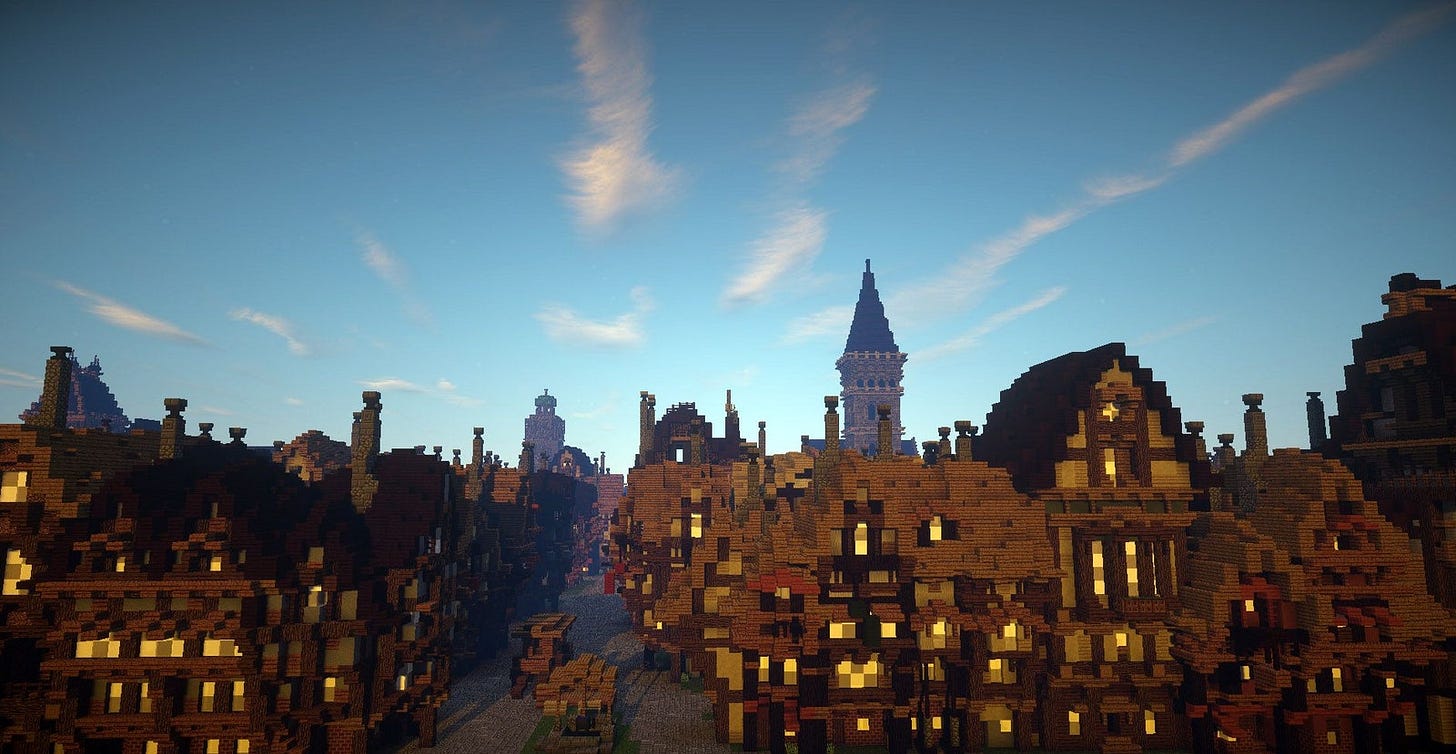Welcome to The Gameful Scientist! This newsletter explores the intersection of scientific discovery and creativity. Enjoy!

Imagine being able to create and control living things in a virtual world, just like building structures in a sandbox game like Minecraft. Synthetic biology, or synbio, enables this by breaking down biology into building blocks that players can play with in an open world.
These games offer a unique way to explore complex scientific concepts by combining realistic biology with engaging gameplay. Players can experiment with genetic parts, modify cells, and build intricate biological systems while learning about the real-world consequences of their creations. In this article, we'll explore the exciting possibility of creating sandbox games that enable players to build with biology. By merging the best of gaming and research, we can bring more creativity to science.
Welcome to Level 5.
Sandbox Games
Sandbox games are digital playgrounds. They provide an unprecedented level of creative freedom to players. Unlike traditional games, sandbox games offer a world where players can experiment, build, and create without predetermined goals or paths.
Minecraft is the best-selling video game of all time. Players can gather resources, craft tools, and build structures using blocks made from various materials they collect. The game's open world environment allows players to express themselves creatively and explore diverse landscapes, such as forests, mountains, deserts, and oceans. With no real storyline or pre-defined objectives, players are free to create anything they can imagine, from a small cabin to an entire city. The open world nature of these types of games provides unique opportunities to experiment with complex concepts and ideas.

Synbio in an Open World
Sandbox games and synbio share a surprising parallel: both enable people to build complex structures from smaller components. In Minecraft, players can craft structures from bricks. In synbio, BioBricks are DNA sequences that can perform various biological functions. These parts are assembled to create more complex biological systems using the engineering principles of abstraction and modularity.
![1. Fundamentals of Synthetic Biology - BioBuilder [Book] 1. Fundamentals of Synthetic Biology - BioBuilder [Book]](https://substackcdn.com/image/fetch/$s_!Y6NG!,w_1456,c_limit,f_auto,q_auto:good,fl_progressive:steep/https%3A%2F%2Fsubstack-post-media.s3.amazonaws.com%2Fpublic%2Fimages%2Ffc78cbd8-cc21-438b-b0d0-3231d72cc4b7_600x1028.png)
Abstraction allows scientists to ignore unnecessary details and focus on a particular level of organization (see above), while modularity enables the components of a system to be separated and recombined. Scientists use programming languages and software to design genetic circuits made up of these parts. These circuits help cells sense, compute, and respond to different stimuli by turning DNA into useful proteins.
Sandbox games could allow players to create new lifeforms and biological systems. Rahul Rana writes that we need more sci-fi stories to build a better future. These stories inspire founders to tackle big challenges and make sense of the fast pace of technology. "Invention needs inspiration, and stories are a powerful tool for inspiring innovation." By creating their own sci-fi world, players can explore the limitless potential of synbio.
Jurassic Park. Oryx and Crake. Vesper.




The iGEM competition provides a space for young people to design, build, test, and learn with BioBricks, enabling them to play with living systems and create incredible things. By bringing this competition to a virtual world, players could expand their imagination and explore the possibilities of synbio even further.
Asimov, winner of probably the coolest name in biotech, recently announced its partnership with iGEM to support teams in designing biological systems. They’ve built a platform called Kernel, which is a computer-aided design (CAD) platform for synbio. It includes an extensive library of biological parts for both bacteria and mammalian systems. This means that, in addition to building interesting things with bacteria, we might see some teams lay the foundation for building with human stem cells. Essentially, designing complex biological systems is now becoming much easier, bringing us closer to the possibility of an open world sandbox game
Crafting a Bio Future
Crafting and inventory management are essential features of sandbox games and have similarities with modern research practices. Researchers today use software like Benchling to store information and track resources collected during their work.
The inventory system in video games is used to track the items and resources that players collect during their journey, ranging from weapons, tools, consumables, to materials. Players can view, manage, and use these items as needed through an inventory interface.
The crafting system allows players to create new items from the resources stored in their inventory. In Minecraft, for example, players can combine things like wood and cobblestone to create a pickaxe. Similarly, in The Legend of Zelda Breath of the Wild, players can collect ingredients from the environment and combine them to create potions and other items.
In synbio, the crafting system takes on a new meaning. The game Hero.Coli, recently introduced to me by the Grove community, lets players modify the abilities of a bacterium and collect genetic parts to craft new skills. In a sandbox game, the ability to use biological parts to craft new systems could provide a new way to experiment and innovate.
The inventory could include:
Genetic Material: DNA, RNA, and plasmids.
Cells: Stem cells, cancer cells, and immune cells.
Microbes: Bacteria, yeast, and fungi.
Media: Agar, serum, and nutrient broth.
Equipment: PCR machines, centrifuges, microscopes, pipettes.
The crafting system might allow the player to create:
New Organisms: By combining different types of cells, genetic material, and growth medium, players could create new, more advanced organisms with specific abilities and properties.
Genetic Enhancements: Using tools and knowledge of genetics, players could modify and enhance existing organisms by adding or removing specific genetic traits.
Biotech Products: Players could use their crafted organisms to create biotech products, such as medicines, biofuels, and other useful items.
Hybrid Organisms: By combining different types of cells and microbes, players could create hybrid organisms with unique abilities and properties.

Solving Real World Problems in a Sandbox
Sandbox games like Minecraft have been used to simulate real-world problems, allowing players to explore and solve these problems in a unique and interactive way.
Here are some examples:
Urban Planning: Minecraft has been used to simulate urban planning scenarios, allowing city planners to experiment with different designs. The Block by Block initiative has used Minecraft to help communities design public spaces, such as parks and playgrounds.
Environmental Sustainability: Minecraft has been used to simulate the impact of climate change and the management of natural resources. MinecraftEdu ClimateCraft allows students to explore the impacts of climate change, while the Blockholm project uses Minecraft to simulate sustainable urban development.
Art and Design: Minecraft has been used to express artistic and creative designs. BlockWorks uses Minecraft to create architectural designs and immersive virtual worlds, while the Museum of London used Minecraft to recreate the city of London in 1666.
Disaster Response: Minecraft has been used to simulate disaster response scenarios, such as earthquakes and floods. Build to Learn uses Minecraft to teach students about disaster response and preparedness.
Sandbox games provide a safe and interactive environment for testing concepts and ideas, which makes them ideal for research. In a sandbox for bio, players can experiment with genetic design, metabolic engineering, drug development, and synthetic ecology to gain insights into biological systems and identify solutions to real-world problems. This type of experimentation, combined with gameplay and competition, can provide a unique approach to problem-solving.
Understanding Bio through Play
In synbio, there's a concept called "build to understand," which involves breaking down complex systems and rebuilding them to learn how they function. In Minecraft, the mod "Morphogenesis" simulates how human cells work together to achieve a common goal using neural networks to learn the rules for cellular behavior. This makes it a valuable tool for exploring and understanding biological processes.

Sandbox games have a key feature called "emergent gameplay," which is when something unexpected and unpredictable happens in the game as a result of players' interactions.
I asked ChatGPT for an example in Minecraft.
One day, while you're exploring a forest, you come across a group of wolves. You remember that you can tame wolves in Minecraft by feeding them bones, so you try to tame one.
After feeding the wolf a few bones, it becomes your loyal companion and follows you around. As you continue exploring the forest, you encounter a group of hostile mobs, such as zombies and skeletons, that attack you. In the chaos of the battle, your wolf companion leaps into action, attacking the mobs and protecting you.
You're amazed at how helpful your wolf is in combat, and you start to rely on it in your adventures. Over time, you realize that your wolf can do more than just fight. You discover that it can also be trained to perform various tasks, such as guarding an area, retrieving items, or even riding on boats and minecarts. You start to experiment with different ways of using your wolf, and before you know it, you've created a unique playstyle that revolves around your trusty companion.
The game developers didn't specifically program the interactions between tamed wolves and hostile mobs, or the various tasks that wolves can be trained to perform. Instead, these features emerged from the game's mechanics and the creative actions of the players, leading to a unique and enjoyable experience that wouldn't have been possible otherwise.
Examples of emergent problem-solving can be found throughout research. A classic example is the discovery of penicillin in 1928, when Alexander Fleming noticed that a mold had contaminated one of his petri dishes and was inhibiting the growth of bacteria. This discovery didn’t come from a pre-planned experiment, but rather emerged from observing something unexpected.
In biotech, Flagship Pioneering, the venture creation firm behind Moderna, has developed a process called “emergent discovery” to systemize this approach. They generate possible solutions by asking "what if" questions, which are then tested, improved, and evaluated through a selection process that involves feedback and problem-solving. For example, Moderna's "what if" question was:
What if we could instruct a patient’s own cells to produce proteins that could prevent, treat, or cure diseases?
Clearly, they found a way to do this. This approach requires a culture that encourages people to share their ideas and view mistakes as opportunities for improvement.
By embracing the unexpected, sandbox games and emergent thinking approaches can lead to more creative problem-solving and innovative solutions.
Balancing Reality and Play
Balancing simulation and abstraction in sandbox games is difficult. Minecraft, for example, doesn’t follow all the laws of physics but does enough to make the structures look realistic. However, simulating a cell is a bit more complicated. It requires a lot of computational power and a complete understanding of biology, which we currently don’t have.
A couple examples of games that balance this well are Spore and Cell Lab: Evolution Sandbox. Both games simulate the evolution of single-celled organisms into more complex beings in various environments.

Petter Säterskog, the creator of Cell Lab, writes:
This simulation is not biologically realistic, all cells in Cell Lab only has one function, to swim, to eat, to collect sunlight, to float, etc . This is not how cells work in nature where one cell can do many things at once. This accuracy has been traded off to be able to make an interesting game. The cells have also been made to multiply very fast, this also for the enjoyment of the user. What is realistic is the evolution taking place in this game. How species adapt to their environment and compete with each other to sometimes attain an equilibrium and sometimes extinction.
For a synbio sandbox game, accurate information on biological parts is necessary, which is where partnerships like Asimov and iGEM come in handy. However, predicting the function of every genetic circuit in a playable cell is unrealistic, which is why we’ll need to incorporate a level of abstraction that loosely follows the laws of biology while still feeling believable, similar to how Minecraft uses physics.
The Future of Bio Sandbox Gaming
Sandbox games can be a powerful tool for advancing synbio. They bring together scientists, gamers, and artists to create innovative games that simulate real-world problems. Imagine a Roblox-style game that lets scientists create their own challenges and competitions to integrate ambitious iGEM proposals or solve real-world problems. With programming biology becoming more accessible, this could become a reality.
As we continue to improve our tools for engineering biology, sandbox games can also evolve with updated inventory and crafting systems. The potential of using xenobots, programmable living robots, in a virtual environment is a thrilling possibility.
Play and innovation in a sandbox.
See you next week :)
Thanks for reading The Gameful Scientist! I’d love to hear your thoughts below.
Feel free to contact me here or chat with me on Twitter @ATrotmanGrant :)







To build a synbio sandbox game will the foundational cause and effect data be pulled from primary scientific literature? If so, how will you know that you can rely on the validity of published results?